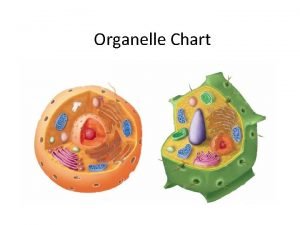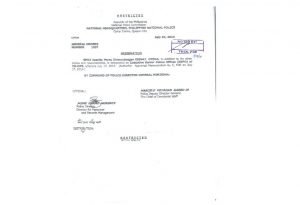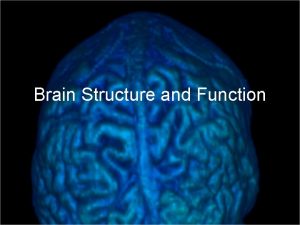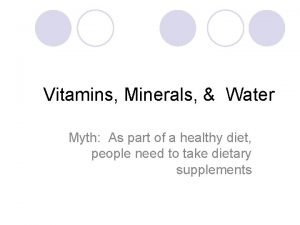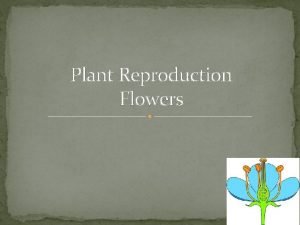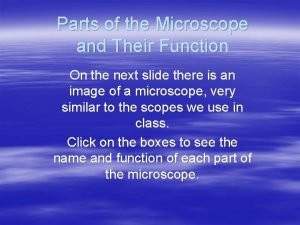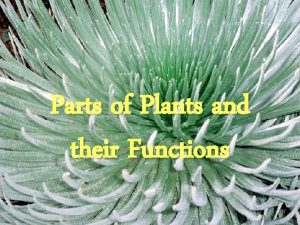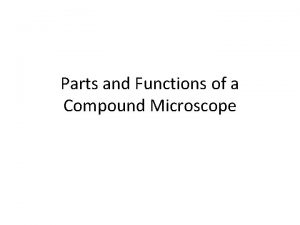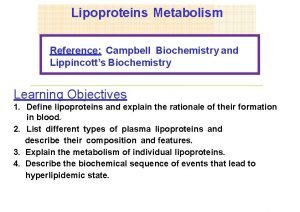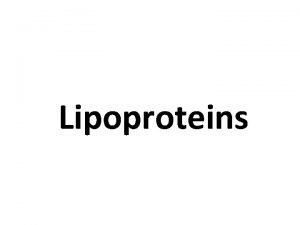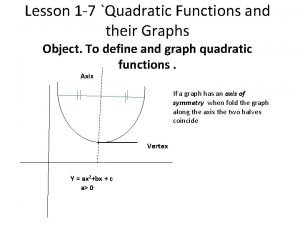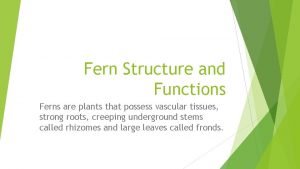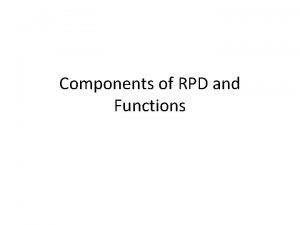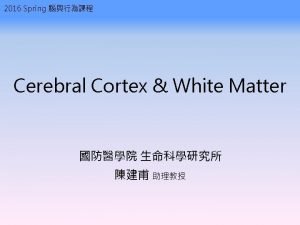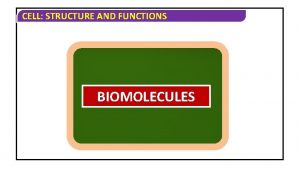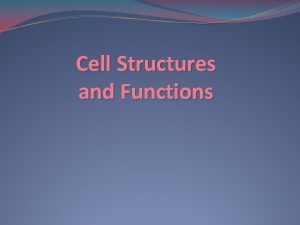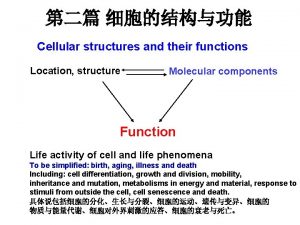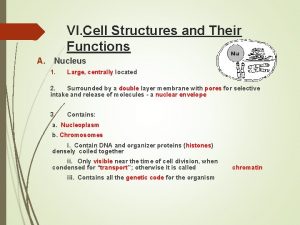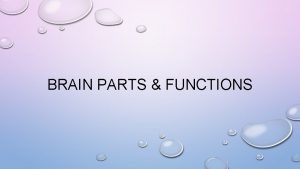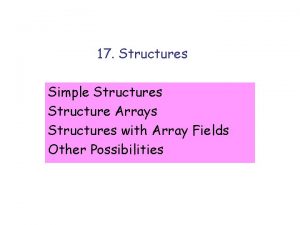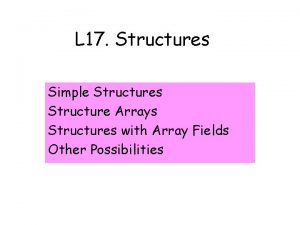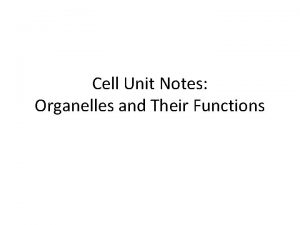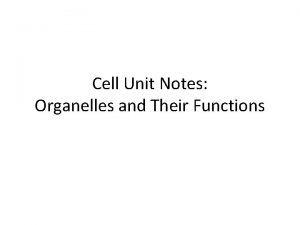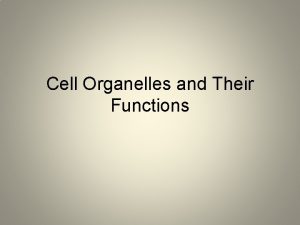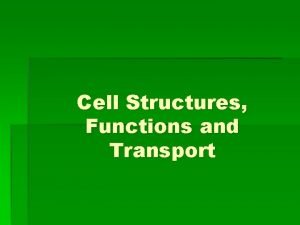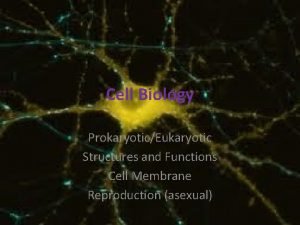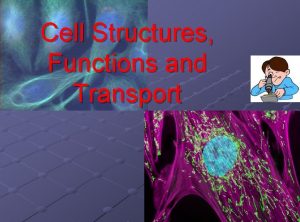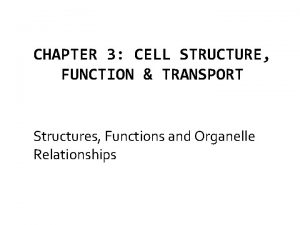Cell Structures and Their Functions Cell Structure n
























- Slides: 24

Cell Structures and Their Functions

Cell Structure n Highly Organized . Specialized structures called organelles in a jelly like substance called cytoplasm Amount and type of organelles is related to function

Functions of the Cell n n n Basic Unit of Life -smallest part that still retains characteristics of life Protection And Support – cells secrete substances that provide Movement- occurs because of molecules that are located in specific cells e. g. muscle cells Communication-cells receive information that allow them to communicate with each other eg nerves cell tells muscle cells to contract Cell metabolism and energy release- all the chemical reactions that occur within the cell Inheritance – each cell contains a copy of the genetic information of the individual

The Organelles n n n The Nucleus Cytoskeleton The Cell Membrane Nucleoli and Ribosomes Rough and Smooth Endoplasmic Reticulum The Golgi Apparatus Secretory Vesicles Lysosomes and Peroxiisomes Mitochondria Centrioles Cilia, Flagella and Microvilli


Cell Membrane n n n Phospholipid Bilayer Protection and Transport Types of Transport --Active ( requires ATP) --Passive

Nucleus n n n Contains the genetic material of cell (DNA) Located near the center of the cell Some cells lose their nucleus as they mature, some have more than one nucleus bone cells Nuclear envelop (outer and inner membranes and nuclear pores) Contains loosely coiled fibers called chromatin consisting of DNA When a cell divides the chromatin becomes more tightly coiled to form the 23 pairs of chromosomes

DNA and RNA n n n DNA has 4 nitrogenous bases : adenine, guanine, cytosine and thiamine plus the sugar deoxyribose RNA has 4 nitrogenous bases : adenine, guanine, cytosine and uracil plus the sugar ribose. Remember there are 64 sets of codons (a codon is 3 base pairs) that encode for only 20 amino acids

RNA n n n m. RNA t RNA r RNA

Nucleoli and Ribosomes n n Nucleoli- are rounded dense well defined nuclear bodies with no surrounding membranes Ribosome's- are the organelles where proteins are produced -may be free -attached to the endoplasmic reticulum -made in the nucleus

Smooth and Rough Endoplasmic Reticulum n n The ER is a series of membranes forming sacs and tubules that extends from the outer nuclear membrane into the cytoplasm Rough ER has ribosomes attached indicting that it is synthesizing large amounts of protein for export from the cell

Protein Synthesis n Transcription n Translation

Protein Synthesis n n n DNA in nucleus is Transcribed to m. RNA is translated at the level of the ribosomal subunits where the codons are read and translated into amino acids The amino acids form peptide bonds to create one larger protein


The Golgi Apparatus n n Golgi Apparatus- closely packed stacks of curved membrane –bound sacs. Its function is to collect modify , package and distribute proteins and lipids manufactured by the Endoplasmic Reticulum May also chemically modify the proteins by attaching carbohydrates or lipids to them Found in great number in cells tat make a great deal of protein e. g. pancreas

Secretory Vesicles n n a vesicle is a small membrane bound sac that transports or stores materials within cells Secretory vesicles – pinch off from the golgi apparatus and move to the surface of the cell. Their membranes fuse with the cell membrane and release contents to the exterior of the cell

Lysosomes and Peroximes n n Lysosomes are membrane bound vesicles formed from the golgi apparatus. They contain a variety of enzymes that functions as intracellular digestive systems Peroxisomes small membrane bound vesicles containing enzymes that break down fatty acids , amino acids and hydrogen peroxide.


Mitochondria n n Mitochondria- small bean shaped, long threadlike organelles that has inner and outer membranes separated by a space. The outer membranes have a smooth core but the inner membrane has numerous folds called cristae Site of ATP production within the cells and carry out aerobic respiration.


Cytoskeleton n Cytoskeleton- consists of proteins that support the cell , hold organelles in place and enable the cell to change shape.

Elements of Cytoskeleton n Microtubules n Microfilaments n Intermediate filaments


Centrioles n n n Centosome- a specialized zone of cytoplasm close to the nucleus that is the center of microtubule formation. It contains the centrioles normally oriented perpendicular to each other Shaped like a cylinder and has nine triplets , each consisting of three parallel microtubules joined together.
 Cell structure graphic organizer
Cell structure graphic organizer Cell organelle graphic organizer answer key
Cell organelle graphic organizer answer key Cell organelles and their functions chart
Cell organelles and their functions chart Philippine national police organizational structure
Philippine national police organizational structure Parts of bean seed
Parts of bean seed Analogous structure
Analogous structure Limbic system structures and functions
Limbic system structures and functions Function of amygdala in limbic system
Function of amygdala in limbic system Function of minerals
Function of minerals Macronutrients elements
Macronutrients elements Executive branch powers
Executive branch powers Neurotransmitters and their functions
Neurotransmitters and their functions Parts of a flower and their functions
Parts of a flower and their functions Parts of green plants
Parts of green plants Function of parts of microscope
Function of parts of microscope Function of plant
Function of plant Parts of a compound light microscope and their functions
Parts of a compound light microscope and their functions Types of lipoprotein and their functions
Types of lipoprotein and their functions Types of lipoproteins
Types of lipoproteins Unit 3 lesson 3 rational functions and their graphs
Unit 3 lesson 3 rational functions and their graphs Quadratic functions and their graphs
Quadratic functions and their graphs Fern frond
Fern frond Rpd minor connector
Rpd minor connector Removable and non removable discontinuities
Removable and non removable discontinuities Lobes of the cerebral cortex and their functions
Lobes of the cerebral cortex and their functions


